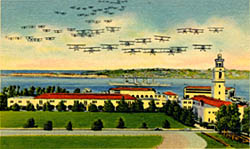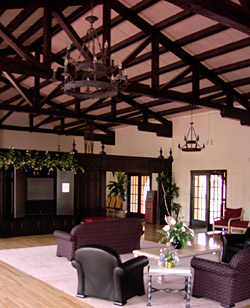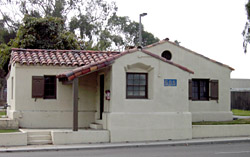
Rockwell Field, located on North Island in San Diego, California, was originally called the Signal Corps Aviation School. It was the first U.S. Army school to provide flying training for military pilots, and North Island was the school's first permanent location. The Aviation School was officially established on North Island in 1912; existing historic and architecturally significant buildings reflect the use and development of Rockwell Field from 1918 to 1935. In 1910, climatic conditions, flat terrain, good beaches and protected stretches of water attracted Glenn H. Curtiss, aviation pioneer and Wright Brothers' competitor, to North Island, where he soon founded his Aviation School. In January 1911, Curtiss signed a contract with the owner of North Island to use the land for three years for a flying school, which was established in February 1911. Curtiss invited the Army and the Navy to send officers to his new school for flying training. The Army sent three airmen to the Curtiss school in early 1911, but they were ordered to Texas before completion of their training. During the winter of 1911 to 1912, the Navy sent three pilots to the Curtiss school for flying training. The Army's Signal Corps Aviation School relocated from its original location at College Park, Maryland, to North Island, San Diego, during November to December 1912. The Army flyers established a tent camp at the north end of North Island, and for about a year, the Signal Corps Aviation School rented airplanes and hangars constructed for the Curtiss school. None of the buildings from this early period, constructed on the north end of the island, are still extant.
On July 20, 1917, the Signal Corps Aviation School was named Rockwell Field in honor of 2nd Lt. Lewis C. Rockwell, killed in a crash at College Park in 1912. Also in July, Congress authorized the President to proceed with the taking of North Island for Army and Navy aviation schools. There was a desperate needed for trained military pilots as the United States had entered World War I earlier in the year. President Woodrow Wilson signed an Executive Order in August 1917 for condemnation of the land, which was still privately owned. The Army turned over the north end of the island to the Navy and relocated to the south end of North Island, the location of the Rockwell Field Historic District. The Navy's first occupancy of North Island occurred on September 8, 1917, but Congress did not authorize the purchase of North Island, for $6, 098,333, until July 1919. The Army selected well-known Detroit industrial architect, Albert Kahn, to develop a site and building designs. Permanent construction of Kahn's design began in mid-1918. During World War I, Rockwell Field provided training for many of the pilots and crews sent to France. It also was the source of men and aircraft for the Sixth and Seventh Aero Squadrons, which established the first military aviation presence in Hawaii and the Panama Canal Zone, respectively.

After World War I, construction came to a complete standstill. Rockwell Field did not fare well into the early 1920s. It was demoted from one of the major Army Air Service training fields on the West Coast to an Aviation General Supply and Repair Depot in 1920 and redesignated again as Rockwell Air Intermediate Depot in 1922. By 1922 there were only 10 officers, two warrant officers, 42 enlisted men, and 190 civilians employed at the airfield. Lt. Jimmy Doolittle landed there in September 1922 after establishing a new record for the first transcontinental flight within a single day. The first nonstop transcontinental flight, originating at Roosevelt Field, New York, was accomplished by Army pilots and ended at Rockwell Field in May 1923. In June of that year, pilots from Rockwell Field conducted the first complete mid-air pipeline refueling between two airplanes. As the Navy's emphasis began shifting from seaplanes to the land planes used on aircraft carriers, its requirement for land increased. Eventually, agreement was reached within the War Department to grant the Navy complete control of North Island. After visiting the air station and the Army airfield on an inspection tour in October 1935, President Franklin Roosevelt issued an Executive Order transferring Rockwell Field and all of its buildings to the Navy. The Army moved most of their aircraft to March Field in Riverside, California, but it took another three years to completely phase-out Army activities at North Island.

The historic and architecturally significant buildings of Rockwell Field form the southeastern quadrant of what is today the Naval Air Station, North Island (NAS North Island). The buildings were designed in the Mission Revival and Spanish Colonial Revival styles. The Kahn-designed Mission Revival Field Officers Quarters (later married officers quarters) are reinforced concrete-framed, in-filled with hollow terra cotta tile and finished in buff color stucco. Kahn's Mission Revival Hangars (Buildings 501, 502 and 503 from 1918) are similar in materials with red clay-tile, gabled roofs. They were built to the same plan: a rectangle, 135 feet by 70 feet, with 30 feet clear to the ceiling. A low, flat-roofed, lean-to on the east side of each contained offices. Located on the bluff edge at the North Island end of the Coronado-North Island causeway, the Army-Navy Gate House/Meter Room (Building 505, 1918; later Meter House) functioned as the gatehouse for both Rockwell Field and NAS San Diego. This group of buildings reflects the War Department's plan to create buildings that would be appropriate for Southern California, and illustrates Kahn's "Spanish military" design implemented at Rockwell Field.
Visit the National Park Service Travel American Aviation to learn more about Aviation related Historic Sites.
Last updated: August 29, 2017
